RBSE Solutions for Class 11 Physics Chapter 9 Mechanical Properties of Solids
Rajasthan Board RBSE Solutions for Class 11 Physics Chapter 9 Mechanical Properties of Solids Textbook Exercise Questions and Answers.
Rajasthan Board RBSE Solutions for Class 11 Physics in Hindi Medium & English Medium are part of RBSE Solutions for Class 11. Students can also read RBSE Class 11 Physics Important Questions for exam preparation. Students can also go through RBSE Class 11 Physics Notes to understand and remember the concepts easily.
RBSE Class 11 Physics Solutions Chapter 9 Mechanical Properties of Solids
RBSE Class 11 Physics Mechanical Properties of Solids Textbook Questions and Answers
Question 9.1.
A steel wire of length 4.7 m and cross sectional area 3.0 x 10-5 m2 stretches by the same amount as a copper wire of length 3.5 m and cross sectional area 4.0 x 10-5 m2 under a given load. What is the ratio of the Young’s modulus of steel to that of copper?
Answer:
Given, for steel L = 4.7 m,
A = 3.0 x 10-5 m2
For copper L = 3.5 m, A = 4.0 x 10-5 m2
The applied force F and extension ∆L are same for both the wires.
∴ Young’s modulus of steel,
YS = \(\frac{F L}{A \Delta L}=\frac{F \times 4.7}{3.0 \times 10^{-6} \times \Delta L}\)
∴ Young’s modulus for copper,
YC = \(\frac{F L}{A \Delta L}=\frac{F \times 3.5}{4.0 \times 10^{-5} \times \Delta L}\)
∴ \(\frac{Y_S}{Y_C}=\frac{F \times 4.7}{3.0 \times 10^{-5} \times \Delta L} \times \frac{4.0 \times 10^{-5} \times \Delta L}{F \times 3.5}\)
= 1.79

Question 9.2.
The figure below shows the stress-strain curve for a given material. What are (a) Young’s modulus and (b) approximate yield strength for this material?
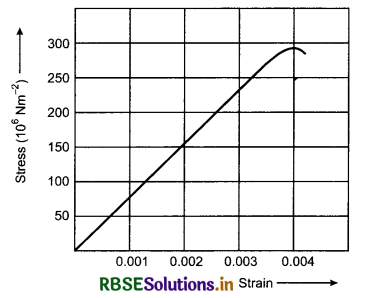
Answer:
It is very clear from the graph that for a stress of 150x 106 Nm-2; the strain is 0.002.
(a) ∴ Young’s modulus,
Y = \(\frac{\text { Stress }}{\text { Strain }}=\frac{150 \times 10^6 \mathrm{Nm}^{-2}}{0.002}\)
Y = 7.5 x 1010 Nm-2
(b) Near the bend of the curve, the stress is nearly 300 x 106 Nm-2
∴ Approximate yield strength of the material
= 3 x 108 Nm-2
Question 9.3.
The stress-strain graphs for materials A and B are shown in the figures below:
The graphs are drawn on the same scale.
(a) Which of the material has greater Young’s modulus?
(b) Which of the two is stronger material?
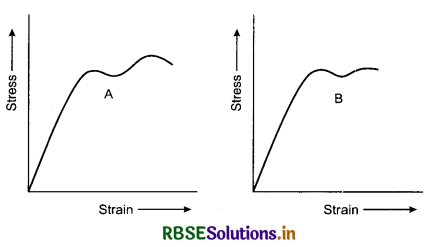
Answer:
(a) Young’s modulus = \(\frac{\text { stress }}{\text { strain }}\) = slope of stress-strain graph since, the slope of stress-strain graph for material A is higher than that for material B, so material A has greater Young’s modulus than R
(b) Material A is stronger than R because it can withstand greater stress before breaking.
Question 9.4.
Read each of the statements below carefully and state with reasons; if it is true or false.
(a) The modulus of elasticity of rubber is greater than that of steel.
(b) The stretching of a coil is determined by its shear modulus.
Answer:
(a) The statement is false.
When same deforming force is applied on steel and rubber, there is less extension is steel and hence strain is less in case of steel than in rubber.
Since Y = \(\frac{\text { stress }}{\text { strain }}\)
∴ Y is more in case of steel than that of rubber.
(b) The statement is true.
When the coil is stretched, there is no change in the length or the volume of the wire used in the coil. There is only a change in the shape of the spring, so shear modulus is involved.
Question 9.5.
Two wires of diameter 0.25 cm, one made of steel and the other made of brass are loaded as shown in the figure below. The unloaded length of steel wire is 1.5 m and that of brass wire is 1.0 m. Young’s modulus of steel is 2.0 x 1011 Pa and that of brass is 0.91 x 1011 Pa. Compute the elongations of steel and brass wires. (1 Pa = 1 Nm-2).
Answer:
For steel wire:
Length, L1 = 1.5 m
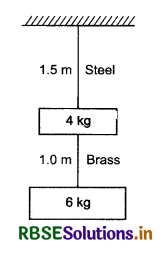
Radius r1 = \(\frac{0.25 \mathrm{~cm}}{2}\) = 1.25 x 10-3 m
Young's modulus,
Y1 = 2.0 x 1011 Nm-2
Total force on steel wire,
F1 = (4 kg + 6 kg) (10 m/s2) = 100 N
For brass wire:
Length, L2 = 1.0 m,
Radius r2 = \(\frac{0.25}{2}\) = 1.25 x 10-3 m
Young's modulus, Y2 = 0.91 x 1011 N/m-2
Force on brass wire,
F2 = (6 kg) (10 m/s2) = 60 N
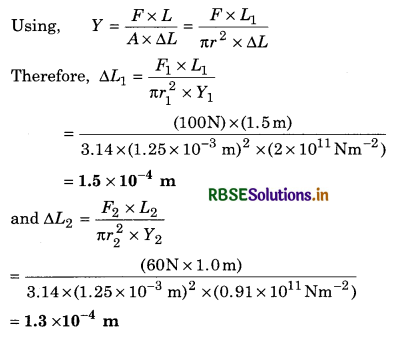

Question 9.6.
The edge of an aluminium cube is 10 cm long. One face of the cube is firmly fixed to a vertical wall. A mass of 100 kg is then attached to the opposite face of the cube. The shear modulus of aluminium is 25 GPa. What is the vertical deflection of this face? (1 Pa = 1 Nm-2)
Answer:
Area of the face on which force is applied,
A = 10cm x 10cm = 100cm2 = 100 x 10-4 m2 = 10-2 m2
[where side of the given cube is L = 10 cm]
Tangential force acting on the face of the cube
F = Mg = 100 x 10 = 1000N
Given, shear modulus η = 25GPa = 25 x 109 Pa
Since, shear modulus = \(\frac{\text { Tangential stress }}{\text { shear strain }}\)
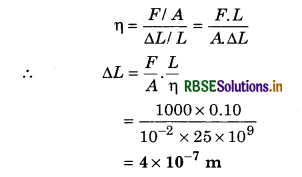
Question 9.7.
Four identical hollow cylindrical columns of mild steel support a big structure of mass 50,000 kg. The inner and outer radii of each column are 30 cm and 60 cm respectively. Assuming the load distribution to be uniform. Calculate the compressional strain of each column. The Young’s modulus of steel is 2.0 x 1011 Pa.
Answer:
The question states that the load is equally distributed.
∴ Load on each column
F = \(\frac{1}{4}\) mg
= \(\frac{1}{4}\) (50000 kg) (10 m/s2)
= 125000 N
Area of each column
A = π(r22 - r12)
= (3.14) [(0.60m)2 - (0.30m)2]
= 0.85 m2
Young’s modulus of steel
Y = 2.0 x 1011 Nm-2
∴ Compressional strain
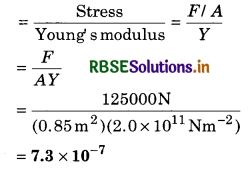
Question 9.8.
A piece of copper having a rectangular cross section of 15.2 mm x 19.1 mm is pulled in tension with 44,500 N force producing only elastic deformation. Calculate the resulting strain.
Answer:
Given, force F = 44500 N
A = 15.2mm x 19.1 m
= 15.2 x 19.1 x 10-6 m2
Young's modulus for copper
Y = 1.2 x 1011 Nm-2
since, Y = \(\frac{\text { stress }}{\text { strain }}=\frac{F / A}{\text { strain }}\)
∴ strain = \(\frac{F}{A Y}=\frac{44500}{\left(15.2 \times 19.1 \times 10^{-6}\right) \times\left(1.2 \times 10^{11}\right)}\)
= 0.001277
= 1.27 x 103
Question 9.9.
A steel cable with a radius of 1.5 cm supports a chairlift at a ski area. If the maximum stress is not to exceed 108 Nm-2, what is the maximum load the cable can support?
Answer:
The maximum limit of stress is given as 108 Nm-2.
The radius (r) of the steel cable = 1.5 cm
= 1.5 x 10-2 m
Area of cross section (A) = πr2
∴ Maximum stress = \frac{\text { Maximum load }}{\text { Area of cross section }}
Maximum load = maximum stress x area of cross section
= (108 Nm-2) x [3.14 x (1.5 x 10-2 m)2]
= 7.07 x 104 N
Question 9.10.
A rigid bar of mass 15 kg is supported symmetrically by three wires each 2.0 m long. Those at each end are of copper and the middle one is of iron. Determine the ratios of their diameters if each is to have the same tension.
Answer:
Let T be the tension in each wire. As the bar is supported symmetrically by the three wires, the incresae in length ∆L of each wire should be same.
Now, Y = \(\frac{T}{A} \frac{L}{\Delta L}\)
For all wires, we have same L, ∆L and T.
Hence, Y ∝ \(\frac{1}{A}\) or A ∝ \(\frac{1}{Y}\)
or \(\frac{\pi D^2}{4} \propto \frac{1}{Y}\) or D ∝ \(\frac{1}{\sqrt{Y}}\)
where, D is the diameter:
∴ \(\frac{D_{\text {copper }}}{D_{\text {iron }}}=\sqrt{\frac{Y_{\text {iron }}}{Y_{\text {copper }}}}\)
= \(\sqrt{\frac{1.9 \times 10^{11} \mathrm{~Pa}}{1.1 \times 10^{11} \mathrm{~Pa}}}\) = 1.3

Question 9.11.
A 14.5 kg mass, fastened to the end of a steel wire of unstretched length 1.0 m, is whirled in a vertical circle with an angular velocity of 2 rev/s at the bottom of the circle. The cross-sectional area of the wire is 0.065 cm2. Calculate the elongation of the wire when the mass is at the lowest point of its path.
Answer:
Given: mass, m = 14.5 kg
Length of steel wire, l = 1 m = r (r is the radius of the circle)
Cross-sectional area of the wire A = 0.065 cm2
= 0.065 x 10-4 m2
Young’s modulus of steel, r = 2.0 x 1011 Nm-2
∴ The total centripetal force at the lowest point
F = mg + mrω2
= (14.5 kg x 9.8 ms-2) + [14.5 kg x 1 m x (2rad s-1)2]
= 142.1 N + 58 N
= 200.1 N
Since, Y = \(\frac{\text { Stress }}{\text { Strain }}=\frac{F / A}{\Delta L / L}\)
∴ ∆L = \(\frac{F L}{A Y}=\frac{200.1 \times 1}{0.065 \times 10^{-4} \times 2.0 \times 10^{11}}\)
= 1.539 x 10-4 m
Question 9.12.
Compute the bulk modulus of water from the following data : Initial volume = 100.0 litre, pressure increase = 100.0 atm, final volume = 100.5 litre (1 atm = 1.013 x 105 Pa). Compare the bulk modulus of water with that of air (at constant temperature). Explain in simple terms why the ratio is so large.
Answer:
Given, p = 100 atm = 100 x 1.013 x 105 Pa
Initial volume, V = 100.0 litre = 100.0 x 10-3 m3
Final volume, V'= 100.5 litre = 100.5 x 10-3 m3
Increase in volume
∆V = (100.5 - 100.0) x 10-3 = 0.5 x 10-3 m3
∴ Bulk modulus of water
K = \(\frac{p V}{\Delta V}=\frac{100 \times 1.013 \times 10^5 \times 100.0 \times 10^{-3}}{0.5 \times 10^{-3}}\)
= 2.026 x 109 Pa
Question 9.13.
What is the density of ocean water at a depth, where the pressure is 80.0 atm, given that its density at the surface is 1.03 x 103 kg m-3? Compressibility of water = 45.8 x 10-11 Pa-1. Given 1 atm = 1.013 x 105 Pa.
Answer:
Given: Pressure p = 80.0 atm
= 80.0 x 1.013 x 105 Pa
Bulk modulus of water B = 2.026 x 109 Pa (1 Pa = 1 Nm-2)
Let ρd be the density of water at depth, so,
VS = \(\frac{M}{P_S}\) and Vd = \(\frac{M}{P_d}\)
where VS and Vd are the volumes of certain mass M of water at the surface and at a given depth. Now, volumetric strain,
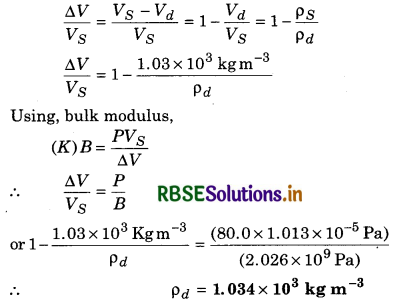
Question 9.14.
Compute the fractional change in volume of a glass slab, when subjected to a hydraulic pressure of 10 atm.
Answer:
Its given in the question that, hydraulic pressure applied on a glass slab is
P = 10 atm = 10 x 1.013 x 105 Pa
Also, bulk modulus of elasticity of glass
K = 37 x 109 Pa
∴ Bulk modulus, K = \(\frac{P V}{\Delta V}\)
∴ Fractional change in volume of glass slab
\(\frac{\Delta V}{V}=\frac{P}{K}=\frac{10 \times 1.013 \times 10^5}{37 \times 10^9}\) = 2.74 x 10-5
Question 9.15.
Determine the volume contraction of a solid copper cube, 10 cm on an edge, when subjected to a hydraulic pressure of 7.0 x 106 Pa.
Answer:
The original volume can be calculated as
V = (10cm)3 = 1000cm3
= 1000 x 10-6 m3 = 10-3 m3
Given pressure ⇒ P = 7.0 x 106 Pa
For copper, K = 140 x 109 Pa
Bulk modulus K = \(\frac{P V}{\Delta V}\)
∴ Volume contraction of copper cube,
∆V = \(\frac{P V}{K}=\frac{7.0 \times 10^6 \times 10^{-3}}{140 \times 10^9}\)
= 0.05 x 10-6 m3 = 0.05 cm3

Question 9.16.
How much should the pressure on a litre of water be changed to compress it by 0.10%?
Answer:
Given, V = 1 litre = 10-3 m3
\(\frac{\Delta V}{V}\) = 0.10% = \(\frac{0.10}{100}\) = 0.001
For water, K = 2.2 x 109 Nm-2
Since, K = \(\frac{P V}{\Delta V}\)
p = \(\frac{K \Delta V}{V}\) = 2.2 x 109 x 0.001
= 2.2 x 106 Nm-2
Additional Exercise of NCERT Text Book
Question 9.17.
Anvils made of single crystals of diamond, with the shape as shown in the figure given below, are used to investigate the behaviour of materials under very high pressures. Flat faces at the narrow end of the anvil have a diameter of 0.5 mm, and the wide ends are subjected to a compressional force of 50,000 N. What is the pressure at the tip of the anvil?
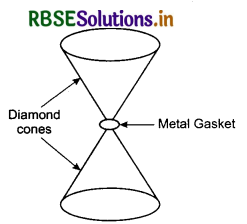
Answer:
Given, diameter = 0.5 mm
∴ Radius, r = 0.25 mm = 0.25 x 10-3 m
F = 50,000 N
∴ Pressure at the tip of the anvil = \(\frac{\text { Force }}{\text { Area }}=\frac{F}{\pi r^2}\)
= \(\frac{50000}{3.14 \times\left(0.25 \times 10^{-3}\right)^2}\)
= 2.55 x 1011 Nm-2
Question 9.18.
A rod of length 1.05 m having negligible mass is supported at its ends by two wires of steel (wire A) and aluminium (wire B) of equal lengths as shown in the figure given below. The cross-sectional areas of the wires A and B use 1.0 mm2 and 2.0 mm2 respectively. At what point along the rod should a mass m be suspended in order to produce (a) equal stresses and (b) equal strains in both steel and aluminium wires?
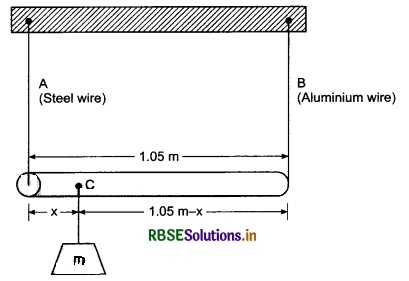
Answer:
Suppose a mass m is suspended at a distance x from the wire A Let T1 and T2 be the tensions in the steel and aluminium wires respectively.
(a) Stress in steel wire = \(\frac{T_1}{A_1}\)
Stress in aluminium wire = \(\frac{T_2}{A_2}\)
As both the stresses are equal, so
\(\frac{T_1}{A_1} = \frac{T_2}{A_2}\) or \(\frac{T_1}{T_2} = \frac{A_1}{A_2} = \frac{1.0 \mathrm{~mm}^2}{2.0 \mathrm{~mm}^2}=\frac{1}{2}\)
Hence, the moments about point C, are equal because the system is in equilibrium.
∴ T1x = T2 (1.05 - x)
or \(\frac{T_1}{T_2} = \frac{1.05-x}{x}\)
\(\frac{1}{2} = \frac{1.05-x}{x}\)
∴ x = 2.10 - 2x
or x = 0.7 m (from steel wire)
(b) Strain = \(\frac{\text { Stress }}{\text { Young's modulus }}\)
∴ Strain in steel wire = \(\frac{T_1 / A_1}{Y_1}=\frac{T_1}{A_1 Y_1}\)
Strain in aluminium wire = \(\frac{T_2}{A_2 Y_2}\)
For the two strains to be equal,
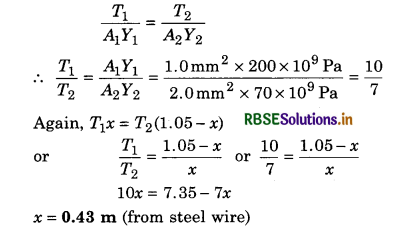
Question 9.19.
A mild steel wire of length 1.0 m and cross sectional area 0.50 x 10-2 cm2 is stretched, well within its elastic limit, horizontally between two pillars. A mass of 100 g is suspended from the mid-point of the wire. Calculate the depression at the mid-point.
Answer:
The figure below clearly shows the situation illustrated. Let the depression at the mid-point be given as 'x'.
Initial length of the steel wire is 1.0 m. The increase in length of the wire when it is pulled down into shape PQR is
∆L = PQ + QC -2L = 2PQ - 2L
= 2(L2 + x2)1/2 - 2L = 2L[1 + \(\frac{x^2}{L^2}\)]1/2 - 2L
= 2L[1 + \(\frac{x^2}{2 L^2}\)] - 2L = \(\frac{x^2}{L}\)
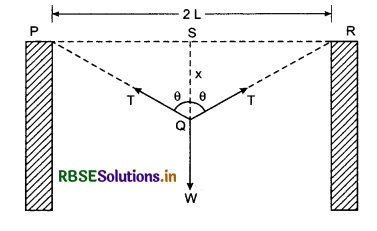
∴ Strain = \(\frac{\Delta L}{2 L}=\frac{x^2}{2 L^2}\)
Let T be the tension in the wire. Now, equating the vertical components of the forces, we get;
2T cos θ = W or T = \(\frac{W}{2 \cos \theta}\)
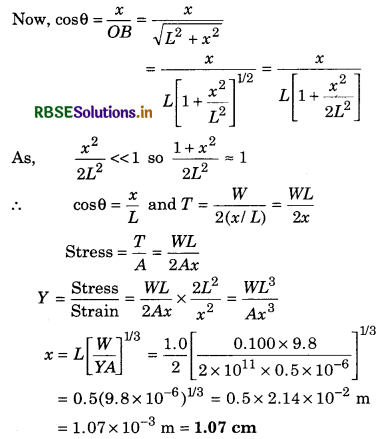
Question 9.20.
Two strips of metal are riveted together at their ends by four rivets, each of diameter 6.0 mm. What is the maximum tension that can be exerted by the riveted strip, if the shearing stress on the rivet is not to exceed 6.9 x 107 Pa? Assume that each rivet is to carry one quarter of the load.
Answer:
Here, diameter of each rivet = 6.0 mm
∴ Radius, r = \(\frac{6.0 \mathrm{~mm}}{2}\) = 3.0 mm = 3.0 x 10-3 m
∴ Maximum load on a rivet
= Maximum shearing stress x Area
= (6.9 x 107 Pa) x (3.14) x (3.0 x 10-3 m)2
= 1950 N
As, each rivet is to carry one quarter of the load, thus, maximum tension = 4(1950N) = 7800 N

Question 9.21.
The Marina trench is located in the pacific ocean, and at one place it is nearly eleven km beneath the surface of water. The water pressure at the bottom of the trench is about 1.1 x 108 Pa. A steel ball of initial volume 0.32 m3 is dropped into the ocean and falls to the bottom of the trench. What is the change in the volume of the ball when it reaches to the bottom?
Answer:
Here, pressure at the bottom of the ocean,
p = 1.1 x 108 Pa
Initial volume of steel ball, V = 0.32 m3
Bulk modulus of steel, K = 1.6 x 1011 Pa
∴ K = \(\frac{P}{\frac{\Delta V}{V}}\)
∴ Change in volume of steel ball.
∆V = \(\frac{P V}{K}=\frac{\left(1.1 \times 10^8 \mathrm{~Pa}\right)\left(0.32 \mathrm{~m}^3\right)}{\left(1.6 \times 10^{11} \mathrm{~Pa}\right)}\)
= 2.2 x 10-4 m3

- RBSE Class 11 Physics Important Questions Chapter 4 Motion in a Plane
- RBSE Solutions for Class 11 Physics Chapter 15 Waves
- RBSE Solutions for Class 11 Physics Chapter 14 Oscillations
- RBSE Solutions for Class 11 Physics Chapter 13 Kinetic Theory
- RBSE Solutions for Class 11 Physics Chapter 12 Thermodynamics
- RBSE Solutions for Class 11 Physics Chapter 11 Thermal Properties of Matter
- RBSE Solutions for Class 11 Physics Chapter 10 Mechanical Properties of Fluids
- RBSE Solutions for Class 11 Physics Chapter 8 Gravitation
- RBSE Solutions for Class 11 Physics Chapter 7 System of Particles and Rotational Motion
- RBSE Solutions for Class 11 Physics Chapter 6 Work, Energy and Power
- RBSE Solutions for Class 11 Physics Chapter 5 Laws of Motion